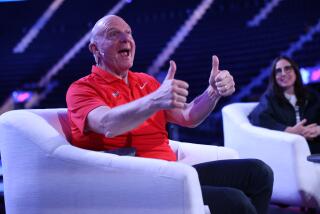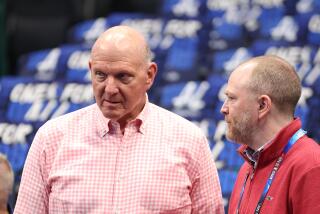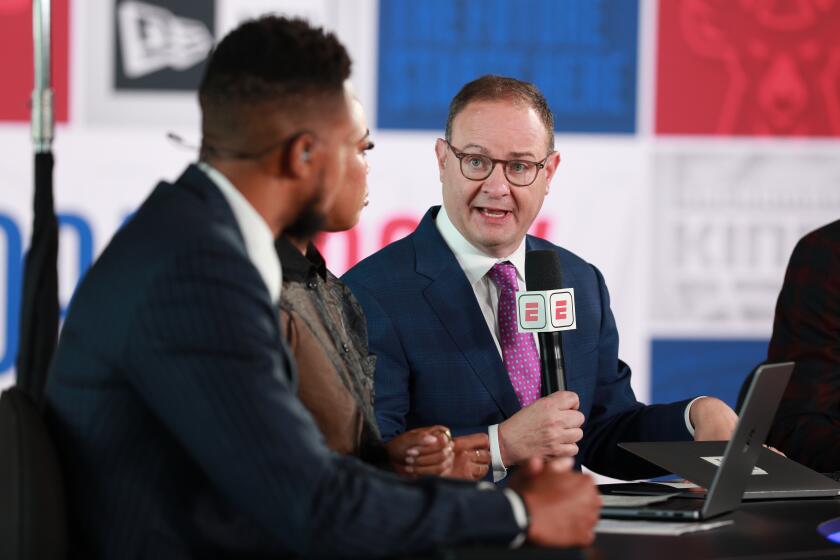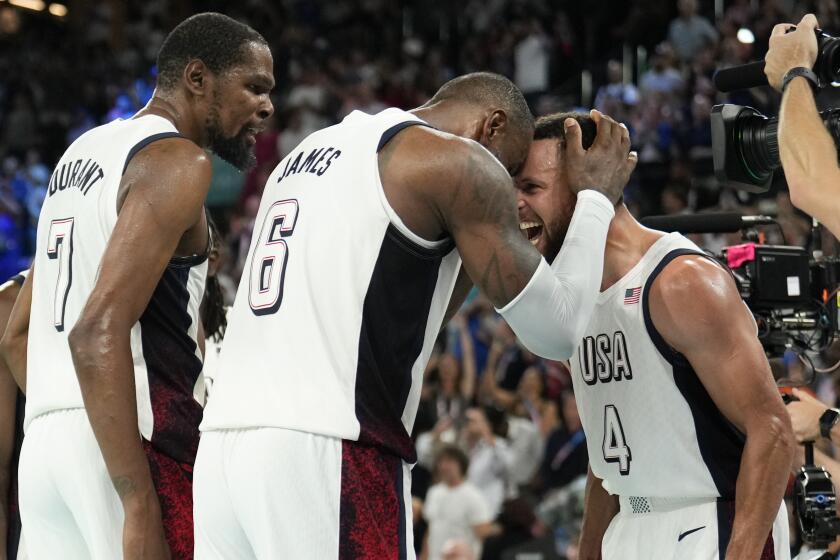NBA makes its case against Clippers owner Donald Sterling
Donald Sterling made several attempts to deflect responsibility for his rant against African Americans — even asking his companion V. Stiviano to lie about the authenticity of the recording of the incident, the NBA contended in a supporting declaration as part of its formal case against the Los Angeles Clippers owner.
The new claim was made by the NBA’s chief investigator and is among a voluminous collection of accusations and statements that the pro basketball league compiled in its effort to strip Sterling and his wife, Shelly, of ownership of the team.
The confidential documents, reviewed by The Times, alleged that Sterling and his wife of 58 years “are not in any sense estranged,” as she has said. Shelly Sterling has been trying to distance herself from her husband as she makes her case to keep half ownership of the Clippers.
The league asserted that it must oust Shelly Sterling as an owner, along with her husband, to avoid the appearance that he is still in charge, which would “undoubtedly and dramatically reduce the value of the team.”
The documents also contended that Clippers President Andy Roeser discussed the recording with Donald Sterling and then instructed an employee to destroy the copy, more than two weeks before it became public.
Roeser, placed on indefinite leave by the NBA, declined to comment.
Sterling, 80, was heard on the recording admonishing Stiviano, 31, not to bring African Americans to Clipper games. The revelation touched off outrage among NBA fans, advertisers and players, who discussed boycotting games just as the league was in the midst of one of its most competitive postseasons ever.
The website TMZ released the recording April 25. Four days later, NBA Commissioner Adam Silver fined Sterling $2.5 million, banned him for life from the league and asked the other 29 franchise holders to force a sale of the team.
Silver said in his statement supporting the case against Sterling that he believed the league faced an “unprecedented crisis” because of Sterling’s remarks and he had to move expeditiously to reassure those connected to the league.
The NBA constitution sets out a timetable that requires Sterling to respond to the charges in writing by May 27. (The league already has rejected a request from his attorney, Maxwell Blecher, to allow three months to mount a rebuttal.) NBA owners will convene for a June 3 hearing, at which the league and the Clippers owner can present their cases.
Sterling, who has owned the team for 33 years, is a real estate magnate whose worth is estimated at $1.9 billion.
Although the Clippers owner did not respond to a request for comment, a
Sterling ally, who asked not to be named because of the sensitivity of the charges, called the NBA’s claims “a smear.”
The NBA presented its case Monday to Sterling in a 30-page document along with hundreds of pages of supporting statements.
The most provocative charges were summarized by David B. Anders, a former assistant U.S. attorney and New York lawyer who led the NBA investigation. In a whirlwind review, Anders and his team interviewed Stiviano and 20 Clippers employees while 14 league officials and others submitted statements.
The intrigue surrounding the recording actually began April 9, according to Anders’ investigation, when team president Roeser was told by a Clippers employee that Stiviano had sent a copy of a recording of Sterling’s disparaging comments.
Roeser told the unnamed employee to delete the recording and related text messages from a phone that contained the material, Anders’ summary said.
“The employee at first questioned Mr. Roeser, asking him if he was sure that the employee should delete the files,” the summary said. “Mr. Roeser said he was sure.”
The Sterling ally downplayed the significance of the destruction of one copy of the recording, saying that the audio revealed nothing more than a private conversation between two adults, which at that time had no material effect on the NBA.
The owner’s associate added that the words only became significant later, when they entered the public domain. “It’s going to be a non-issue,” the ally said. “They are just throwing some mud up against the wall to see what sticks.”
The NBA’s case said that on April 26, the day after the recording became public, Sterling and his wife and Roeser huddled in a San Francisco hotel room, where they were awaiting that night’s playoff game against the Golden State Warriors.
The NBA claimed the group helped work out a statement from the Clippers that said, in part: “We have heard the tape on TMZ. We do not know if it is legitimate or if it has been altered.” The NBA called the statement intentionally misleading, given that Sterling knew that it was his voice on the recording.
Shelly Sterling’s lawyer, Pierce O’Donnell, said she “had no involvement whatsoever in any decision on the content or release of the April 26 statement.”
In a phone conversation with investigator Anders that same day, Donald Sterling denied he made some of the inflammatory statements and suggested other comments must have been altered.
He said, for instance, that he never admonished Stiviano for posting Instagram photos of herself with black people and recalled, instead, that he had told her not to bring “gangbangers” to games because they scared other fans.
Sterling also insisted to Anders that he did not warn Stiviano against bringing Lakers great Magic Johnson to Clippers games. The investigator said Sterling told him that the audio must have been altered to leave that impression.
Sterling suggested in his widely criticized interview with CNN’s Anderson Cooper that he had been racked with jealousy when he urged Stiviano not to bring young black men to Clippers games. Sterling said he had not intended a sweeping condemnation of all African Americans. “It doesn’t have anything to do with blacks in general,” his ally said Tuesday. “It’s these particular guys who are with his girlfriend.”
Anders asserted that Sterling continued to dodge responsibility. Two weeks after the scandal blew up, Stiviano told investigators, Sterling tried to win her back to his side.
Anders described a meeting that occurred May 2 when Stiviano was at the Four Seasons hotel in Beverly Hills for an interview with ABC’s Barbara Walters. Anders said that immediately before the interview, Sterling told Stiviano that he wanted her to make a payment to settle a lawsuit that Shelly Sterling had brought. Shelly Sterling was attempting to recover the money her husband spent buying Stiviano a house and several luxury cars.
If Stiviano paid, “Mr Sterling said that he would return the value of that payment to Ms. Stiviano through back channels,” the investigator contended.
Sterling then asked Stiviano to disavow her previous statements about the authenticity of the recording and to say that she had altered the audio, according to the NBA investigation.
After that exchange, Stiviano told NBA investigators, she asked her lawyers to come into the conference room where the two were talking and told Sterling to repeat his requests. That made Sterling “extremely upset” and he left the hotel, Stiviano said.
Although the NBA’s case focuses primarily on Sterling, this week’s filing suggested that the league was intent on terminating his wife’s ownership interest.
The documents described how Shelly Sterling, 79, owns half of the team through a family trust and notes how closely she has been tied to her husband through nearly 60 years of marriage.
Shelly Sterling told ABC’s Walters that she has considered divorce from her husband many times and remained estranged from him. When he spoke to CNN’s Cooper, Sterling called Shelly his “ex-wife” and said he expected a divorce to proceed.
Shelly Sterling’s lawyer, O’Donnell, said that his client and her husband had been living apart for more than a year, despite the NBA’s claims of their continued involvement, and that she “continues to be unfairly tarnished” by his words and actions.
The NBA is not buying it. Investigators stated that “significant evidence exists in the public record and otherwise that Mr. and Mrs. Sterling are not in any sense estranged.” The document said the couple attended nearly every home game this season together and were seen together in New Orleans for February’s All-Star Game.
The case also noted that the couple spent two days together immediately after the Stiviano recording went public, once emerging from a downtown restaurant where she appeared to answer “of course not” when a reporter asked if Donald Sterling was a racist.
O’Donnell said his client was actually defending herself, thinking the reporter had leveled the charge of racism at her. She met with her husband that night “as part of an attempt to persuade him to apologize for his racist remarks,” O’Donnell said.
Many of the other statements that will be reviewed by NBA owners attempt to show the damage that Sterling created.
Silver suggested that the Clippers owner seemed unaware of the magnitude of his misstep, telling the commissioner five days into the scandal, “There’s nothing in that recording that’s bad.”
The league commissioned an online survey of 530 Clippers supporters earlier this month that seemed to suggest otherwise. It revealed that 45% of respondents were less likely to support the team if Donald Sterling remained as owner.
More to Read
Get our high school sports newsletter
Prep Rally is devoted to the SoCal high school sports experience, bringing you scores, stories and a behind-the-scenes look at what makes prep sports so popular.
You may occasionally receive promotional content from the Los Angeles Times.








